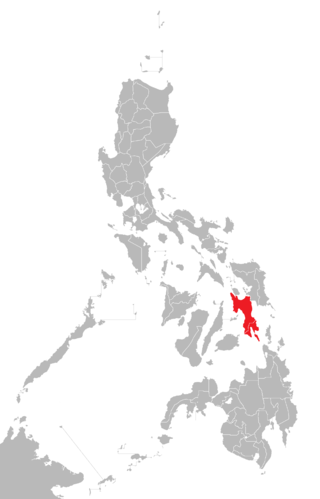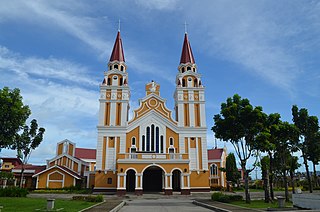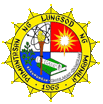
The University of the Philippines Manila - School of Health Sciences in Leyte (UPM - SHS) is a medical school in the Philippines supervised by the University of the Philippines, Manila. [1] One of the schools offerings includes midwifery. [2]

The University of the Philippines Manila - School of Health Sciences in Leyte (UPM - SHS) is a medical school in the Philippines supervised by the University of the Philippines, Manila. [1] One of the schools offerings includes midwifery. [2]
Established in 1976, the School of Health Sciences was seen as the solution to the lack and the inequitable distribution of health professionals serving rural communities in the Philippines. [3] The school started as a two-classroom building and a small nipa hut at the Danilo Z. Romuladez Hospital (now the Eastern Visayas Medical Center) and then in 1981 transferred to its present campus at Palo, Leyte. [4] There are two extension campuses, namely the Baler, Aurora campus opened in 2008 and Koronadal City, South Cotabato campus opened in 2010. [5]
In November 2013, during the onslaught of Typhoon Haiyan in the Philippines, the school's facilities were damaged and programs were interrupted. Help from various groups came quickly to rebuild the school. [6] [7]
The mission of UPM - SHS is to train clinically competent and socially conscious health workers who will stay and serve in depressed and underserved communities especially in the rural areas. It also has the mandate to develop a training model for the training of community oriented health workers that could be replicated in other areas of the Philippines. [4] [8]
The school offers an innovative "step-ladder" curriculum where each student starts at a single point and exits at various levels with varying competencies, first as Community Health Worker (CHW), or Midwife then sequentially as Bachelor of Science in Nursing (BSN), and eventually as Doctor of Medicine (MD). [4] [9] Admissions to this innovative program depend on the needs of the community and the desire of the student to do community work. [6] Rural communities nominate who will be the student assigned to them. [9]

The University of the Philippines is a state university system in the Philippines. It is the country's national university, as mandated by Republic Act No. 9500, giving it institutional autonomy.

Leyte is an island in the Visayas group of islands in the Philippines. It is eighth-largest and sixth-most populous island in the Philippines, with a total population of 2,626,970 as of 2020 census.

Leyte, officially the Province of Leyte, is a province in the Philippines located in the Eastern Visayas region occupying the northern three-quarters of Leyte Island. Its capital is the city of Tacloban, administered independently from the province. Leyte is thus north of Southern Leyte, south of Biliran, and west of Samar Island. To the west across the Camotes Sea is the province of Cebu.

Ateneo de Manila University, also known simply as Ateneo de Manila or Ateneo, is a private, Catholic research university and basic education institution in Quezon City, Philippines. Founded in 1859 by the Jesuits, it is the second-oldest Jesuit-administered institution of higher learning in the Asia-Pacific.

Tacloban, officially the City of Tacloban, is highly urbanized city on Leyte island in the Eastern Visayas region of the Philippines. The city is autonomous from the province of Leyte, although it serves as its provincial capital. According to the 2020 census, Tacloban has a population of 251,881, making it the most populous city in the Eastern Visayas. The city is located 360 miles (580 km) southeast from Manila.

The University of the Philippines Manila is a public, coeducational, research university located in Ermita, Manila, Philippines. It is known for being the country's center of excellence in the health sciences, including health professional education, training, and research. It is the oldest of eight constituent universities of the University of the Philippines System, and predates the founding of UP by three years. It was originally established on December 1, 1905, as the Philippine Medical School and later renamed as the UP College of Medicine and Surgery on June 10, 1907. In 1983 it was renamed as University of the Philippines Manila.

Palo, officially the Municipality of Palo, is a 3rd class municipality in the province of Leyte, Philippines. According to the 2020 census, it has a population of 76,213 people, making it the most populous municipality (non-city) in the province.

The Open University of the Pamantasan ng Lungsod ng Maynila (PLM) or University of the City of Manila headquartered at the Gusaling Don Pepe Atienza at Intramuros, Manila, has operated a continuing education program for working adults and professionals in its partner institutions and agencies in and out of the country. It is designed to provide higher education and improved qualifications to individuals who are unable to take advantage of traditional modes of education because of personal and professional responsibilities. Open University offers undergraduate and postgraduate degree programs.

Arellano University (AU) is a private, coeducational, nonsectarian university located in Manila, the Philippines. It was founded in 1938 as a law school by Florentino Cayco Sr., the first Filipino Undersecretary of Public Instruction. The university was named after Cayetano Arellano, the first Chief Justice of the Supreme Court of the Philippines. It operates seven campuses located throughout Metro Manila and the main campus is located along Legarda Street, Sampaloc, Manila. The Arellano University School of Law is autonomous and managed by the Arellano Law Foundation. Its athletic team, the Arellano University Chiefs, is a member of the National Collegiate Athletic Association since 2009.

Francisco Tiongson Duque III is a Filipino physician and government official who served as Secretary of Health in the Cabinet of President Rodrigo Duterte from 2017 to 2022, a position he had previously held from 2005 to 2009 in the Cabinet of President Gloria Macapagal Arroyo. From 2010 to 2015, he served as the chair of the Civil Service Commission.

The Phi Kappa Mu (ΦΚΜ) is a medical fraternity based in the University of the Philippines College of Medicine. The Greek letters ΦΚΜ stands for Fraternity of the College of Medicine.

Typhoon Haiyan, known in the Philippines as Super Typhoon Yolanda, was one of the most powerful tropical cyclones ever recorded. Upon making landfall, Haiyan devastated portions of Southeast Asia, particularly the Philippines. It is one of the deadliest Philippine typhoons on record, killing at least 6,300 people in that country alone. In terms of JTWC-estimated 1-minute sustained winds, Haiyan is tied with Meranti in 2016 for being the second strongest landfalling tropical cyclone on record, only behind Goni of 2020. As of January 2014, bodies were still being found. Haiyan was also the most intense tropical cyclone worldwide in 2013.

Pope Francis made a pastoral and state visit to the Philippines from January 15 to 19, 2015. He was the third pontiff to visit the Philippines after Paul VI in 1970 and John Paul II in 1981 and 1995, and officially the first papal visit in the 21st century and 3rd millennium after the title was originally scheduled for World Meeting of Families in 2003 but postponed due to John Paul II was unable to attend because of the progression of his Parkinson's disease. Besides Manila, Francis visited Tacloban and Palo, Leyte, to encourage the victims of Typhoon Haiyan (Yolanda) and Typhoon Hagupit (Ruby). The Filipinos nicknamed Francis Lolo Kiko as a term of endearment, which he commended. Around 6–7 million attended Francis' final Papal Mass at Luneta, surpassing the crowd at World Youth Day 1995 in the same venue and making it the largest papal crowd in history. The theme of Francis' 2015 visit was "Mercy and Compassion".

Eastern Visayas is an administrative region in the Philippines, designated as Region VIII. It consists of three main islands, Samar, Leyte and Biliran. The region has six provinces, one independent city and one highly urbanized city namely, Biliran, Leyte, Northern Samar, Samar, Eastern Samar, Southern Leyte, Ormoc and Tacloban. The highly urbanized city of Tacloban is the sole regional center. These provinces and cities occupy the easternmost islands of the Visayas group of islands.

Paulyn Jean Buenaflor Rosell-Ubial is a Filipino physician who served as Secretary of Health on an ad interim basis under the Duterte administration. President Rodrigo Duterte nominated her in 2016, but the Commission on Appointments rejected her appointment in 2017.

Climate change is having serious impacts in the Philippines such as increased frequency and severity of natural disasters, sea level rise, extreme rainfall, resource shortages, and environmental degradation. All of these impacts together have greatly affected the Philippines' agriculture, water, infrastructure, human health, and coastal ecosystems and they are projected to continue having devastating damages to the economy and society of the Philippines.

The COVID-19 pandemic in the Philippines was a part of the worldwide pandemic of coronavirus disease 2019 caused by severe acute respiratory syndrome coronavirus 2. As of April 5, 2024, there have been 4,140,383 reported cases, and 66,864 reported deaths, the fifth highest in Southeast Asia, behind Vietnam, Indonesia, Malaysia, and Thailand. The first case in the Philippines was identified on January 30, 2020, and involved a 38-year-old Chinese woman who was confined at San Lazaro Hospital in Metro Manila. On February 1, 2020, a posthumous test result from a 44-year-old Chinese man turned out positive for the virus, making the Philippines the first country outside China to record a confirmed death from the disease.
The COVID-19 pandemic in Eastern Visayas is part of the worldwide pandemic of coronavirus disease 2019 caused by severe acute respiratory syndrome coronavirus 2. The virus reached Eastern Visayas on March 23, 2020, when the first case of the disease was confirmed in Northern Samar.